Policies via UI
What is a policy?
A policy is composed of a set of rules that are used to perform an evaluation on a source repository or container image. These rules include—but are not limited to—checks on security, known vulnerabilities, configuration file contents, the presence of credentials, manifest changes, exposed ports, or any user defined checks.
Policies can be deployed site wide, or customized to run against specific sources, container images, or categories of application. For additional information, refer to the Policy concepts section.
Once a policy has been applied to a source repository or image container, it can return one of two results:
 indicating that source or image complies
with your policy.
indicating that source or image complies
with your policy. indicating that the source or image is non-compliant with your policy.
indicating that the source or image is non-compliant with your policy.
Rules
Each rule contained within a policy is configured with a check to perform. For
example, check if deny-listed package openssh-server present. The policy
additionally specifies the action to take place, based on the result of the
evaluation.
- STOP: Critical error that should stop the deployment by failing the policy evaluation.
- WARN: Issue a warning.
- GO: Okay to proceed.
Policy rule checks are made up of gates and triggers. A gate is a set of policy checks against broad categories like vulnerabilities, secret scans, licenses, and so forth. It will include one or more triggers, which are checks specific to the gate category.
Listing Policies
The area under the Policies sub-tab in the policy editor contains a table that lists the policies defined within a selected policy. The numeric indicator represents the overall number of polices currently defined in the policy.

Adjacent to each name in the policy list is a counter that indicates the number of rules within that policy.
Note: A lock icon next to the rule counter indicates that the policy cannot be deleted. Policy rules that are used by policy mappings in the policy (which will be listed under the Used By Mapping(s) column entry) cannot be deleted until they are removed from every associated mapping.
Tools
The Tools dropdown menu in the Actions column provides options to:
Edit the policy
Copy the policy
Download the policy as a JSON document
Delete the policy (if it is not being used by any policy mapping)
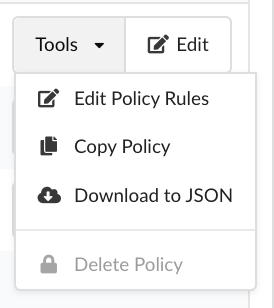
Adding a New Policy
You can add new rule sets to a policy.
Click Add New Rule Set.
Select Source Repository if you want the new policy to apply to a source, or select Container Image to have the policy apply to an image.
Type a uniqe name for the new policy (you can also add an optional description) and click OK.
From the Edit Source Repository Policy Rules modal, set up the policy rules for the new policy. Start by selecting an item from the Gate dropdown list, where each item represents a category of policy checks.
Note: If you are creating a policy rule for a source repository, only vulnerabilities are available.

After selecting a gate item, hover over the (i) indicator next to Gate to see additional descriptive details about the gate you have selected.
Click the Triggers drop down and select a specific check that you want associated with this item, such as package, vulnerability data unavailable, and so on. Triggers may have parameters, some of which may be optional.
If any optional parameters are associated with the trigger you select, these will also be displayed in an additional field where they can be added or removed. Optional parameters are described in more detail in the next section.
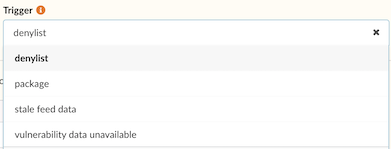
Select an action to apply to the policy rule. Choose STOP, WARN, or GO. The action options are only displayed once all required parameters have been provided, or if no mandatory parameters are required. Once an action has been selected, the rule is added to the main list of rules contained in the policy.
Click Save and Close.
Editing Rule Sets
Existing rule sets from a source repository or container image may be modified.
From Actions, either select Edit, or Tools > Edit Policy Rules. You can also copy a policy, download the policy to JSON, or delete the policy.
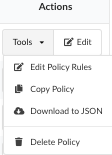
From the Edit Source Repository Policy Rules or Edit Container Image Policy Rules modal (depending on whether you choose to edit a policy for a source repository or container image), you can change the policy name and description.
You can also change any documentation associated with individual policy rules by editing the descriptions presented within each row of the table.

Note: If you are editing a policy rule for a source repository, only vulnerabilities are available under Gate.
The following example shows a sophisticated policy check. The metadata gate has
a single trigger that allows checks to be performed against various attributes
of an image, including image size, architecture, and operating system
distribution:
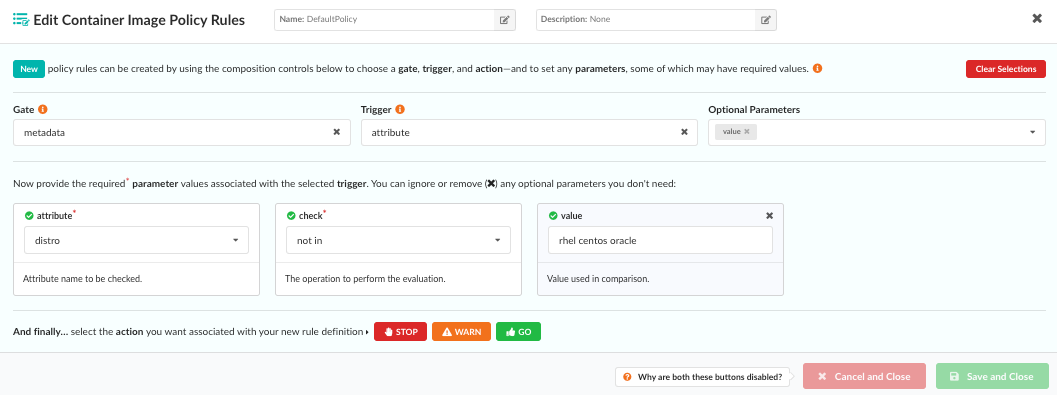
The Attribute parameter drop-down includes a number of attributes taken from image metadata, including the operating system distribution, number of layers, and architecture of the image (AMD64, ARM, and so forth).
Once an attribute has been selected, the Check dropdown is used to create a comparison expression.
The type of comparison varies based on the attribute. For example the numeric
comparison operators such as >, <, >= would be relevant for numeric field
such as size, while other operators such as not in may be useful for querying
data field such as distro.
In this example, by entering rhel centos oracle in the Value field, our
rule will check that the distro (that is, the operating system) under analysis
is not RHEL, Centos, or Oracle.

Optional Parameters
If a trigger has optional parameters, they will be automatically displayed in the policy editor, and an editable field next to the Triggers drop-down will show all the current selections.
You can remove unneeded optional parameters by clicking the X button associated with each entry in the Optional Parameters list, or by clicking the X button within each associated parameter block.
If an optional parameter is removed, it can be reapplied to the rule by clicking the Optional Parameters field and selecting it from the resulting dropdown list.
Editing Rules
After a rule has been added to the policy, you will see it in the the edit policy list page as a new entry.
The final action of each rule can be modified by clicking the STOP, WARN, or GO buttons.
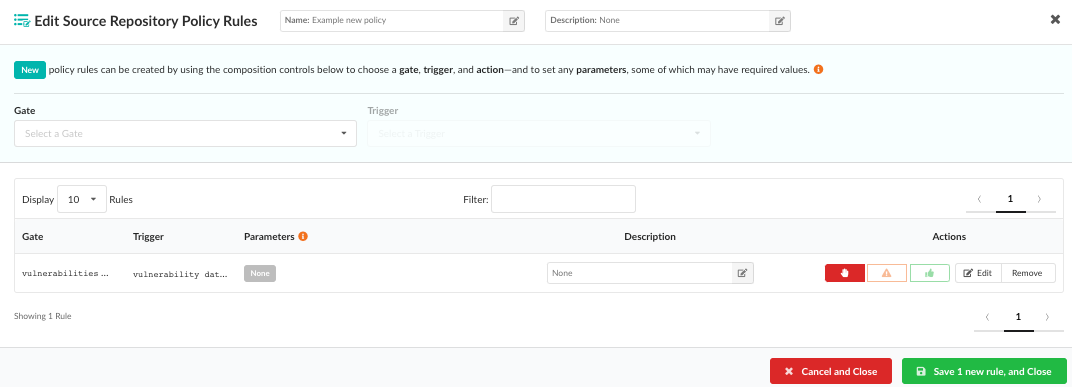
Click Remove to get rid of any unwanted rules.
Click Edit to edit the policy rule again.

After modifying the existing rule, click Apply and the rule will be updated.
When you are satisfied that all your new (or updated) rules are correct, you can click Save new rule, and Close to update and store your policy.